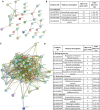Salivary proteome profiling of oral squamous cell carcinoma in a Hungarian population
- PMID: 29632809
- PMCID: PMC5881539
- DOI: 10.1002/2211-5463.12391
Salivary proteome profiling of oral squamous cell carcinoma in a Hungarian population
Abstract
Oral squamous cell carcinoma (OSCC) is the seventh most common malignancy and the ninth most frequent cause of cancer death in Europe. Within Europe, Hungary has one of the highest rates of OSCC incidence and mortality. Thus, there is an urgent need to improve early detection. Saliva, as a readily available body fluid, became an increasingly important substance for the detection of biomarkers for many diseases. Different research groups have identified salivary biomarkers specific for OSCC for different countries. In this study, saliva samples of Hungarian patients with OSCC were studied to discover disease-specific and perhaps region-specific biomarkers. LC-mass spectrometry (MS)/MS analysis on a linear ion trap-Orbitrap mass spectrometer was used for qualitative and quantitative salivary protein profiling. More than 500 proteins were identified from saliva by shotgun proteomics. The up- and downregulated proteins in the saliva of patients with OSCC highlighted the importance of protein-protein interaction networks involving the immune system and proteolysis in disease development. Two potential biomarkers from our shotgun analysis and a third candidate reported earlier by a Taiwanese group were further examined by ELISA on a larger reference set of samples. Resistin, a biomarker reported in Taiwan but not validated in our study, highlights the necessity of application of standardized analysis methods in different ethnic or geographical populations to identify biomarkers with sufficient specificity and sensitivity.
Keywords: ELISA; biomarker; oral squamous cell carcinoma; proteomics analysis.
Figures



Similar articles
-
Proteomics investigation of OSCC-specific salivary biomarkers in a Hungarian population highlights the importance of identification of population-tailored biomarkers.PLoS One. 2017 May 18;12(5):e0177282. doi: 10.1371/journal.pone.0177282. eCollection 2017. PLoS One. 2017. PMID: 28545132 Free PMC article.
-
Saliva proteome profiling reveals potential salivary biomarkers for detection of oral cavity squamous cell carcinoma.Proteomics. 2015 Oct;15(19):3394-404. doi: 10.1002/pmic.201500157. Epub 2015 Aug 20. Proteomics. 2015. PMID: 26205615
-
S100A8 as potential salivary biomarker of oral squamous cell carcinoma using nanoLC-MS/MS.Clin Chim Acta. 2014 Sep 25;436:121-9. doi: 10.1016/j.cca.2014.05.009. Epub 2014 May 24. Clin Chim Acta. 2014. PMID: 24863804
-
Potential biomarkers for oral squamous cell carcinoma: proteomics discovery and clinical validation.Proteomics Clin Appl. 2015 Feb;9(1-2):86-97. doi: 10.1002/prca.201400091. Epub 2014 Dec 28. Proteomics Clin Appl. 2015. PMID: 25431113 Review.
-
Potential biomarkers in saliva for oral squamous cell carcinoma.Oral Oncol. 2010 Apr;46(4):226-31. doi: 10.1016/j.oraloncology.2010.01.007. Epub 2010 Feb 6. Oral Oncol. 2010. PMID: 20138569 Review.
Cited by
-
Saliva proteomics updates in biomedicine.J Biol Res (Thessalon). 2019 Dec 12;26:17. doi: 10.1186/s40709-019-0109-7. eCollection 2019 Dec. J Biol Res (Thessalon). 2019. PMID: 31890650 Free PMC article. Review.
-
Comparative sera proteomics analysis of differentially expressed proteins in oral squamous cell carcinoma.PeerJ. 2021 Jun 10;9:e11548. doi: 10.7717/peerj.11548. eCollection 2021. PeerJ. 2021. PMID: 34178453 Free PMC article.
-
Advances in the Diagnosis, Monitoring, and Progression of Oral Cancer through Saliva: An Update.Biomed Res Int. 2022 Oct 25;2022:2739869. doi: 10.1155/2022/2739869. eCollection 2022. Biomed Res Int. 2022. PMID: 36330456 Free PMC article.
-
The repertoire of mutational signatures in tobacco- and non-tobacco-induced oral cancer.Clin Transl Oncol. 2023 Dec;25(12):3332-3344. doi: 10.1007/s12094-023-03192-8. Epub 2023 Apr 14. Clin Transl Oncol. 2023. PMID: 37058208 Review.
-
Changes in Proteins in Saliva and Serum in Equine Gastric Ulcer Syndrome Using a Proteomic Approach.Animals (Basel). 2022 May 2;12(9):1169. doi: 10.3390/ani12091169. Animals (Basel). 2022. PMID: 35565595 Free PMC article.
References
-
- Massano J, Regateiro FS, Januário G and Ferreira A (2006) Oral squamous cell carcinoma: review of prognostic and predictive factors. Oral Surg Oral Med Oral Pathol Oral Radiol Endod 102, 67–76. - PubMed
-
- Gandini S, Botteri E, Iodice S, Boniol M, Lowenfels AB, Maisonneuve P and Boyle P (2008) Tobacco smoking and cancer: a meta‐analysis. Int J Cancer 122, 155–164. - PubMed
-
- Rosenquist K (2005) Risk factors in oral and oropharyngeal squamous cell carcinoma: a population‐based case‐control study in southern Sweden. Swed Dent J Suppl, 179, 1–66. - PubMed
LinkOut - more resources
Full Text Sources
Other Literature Sources

